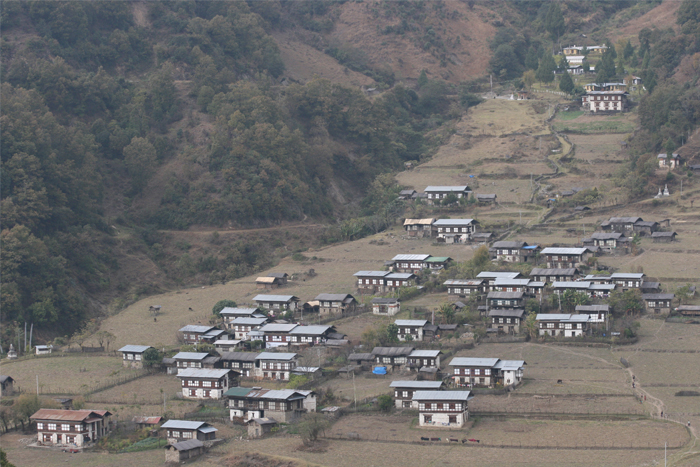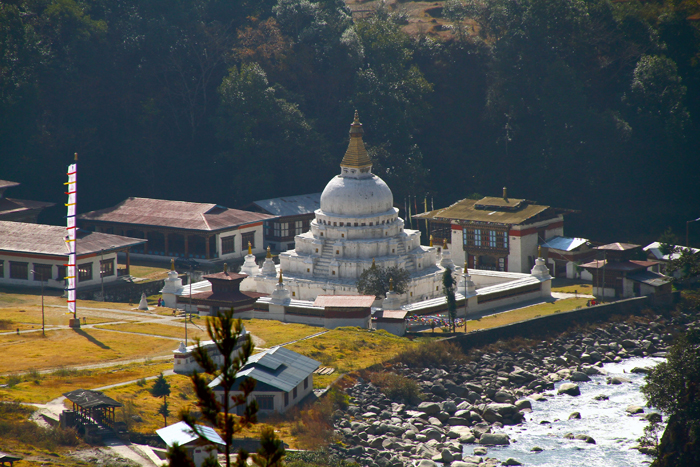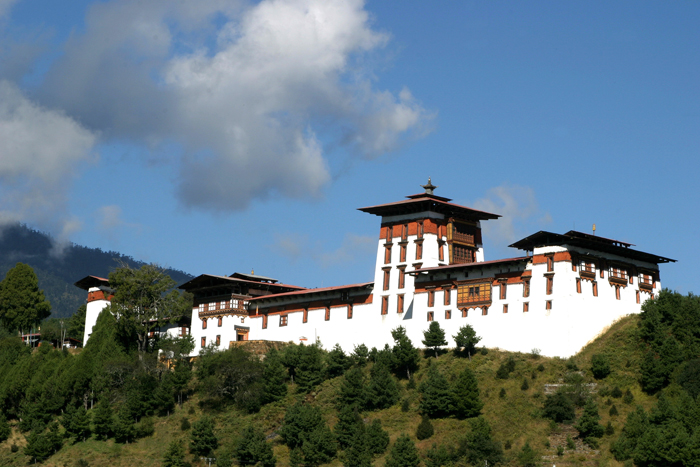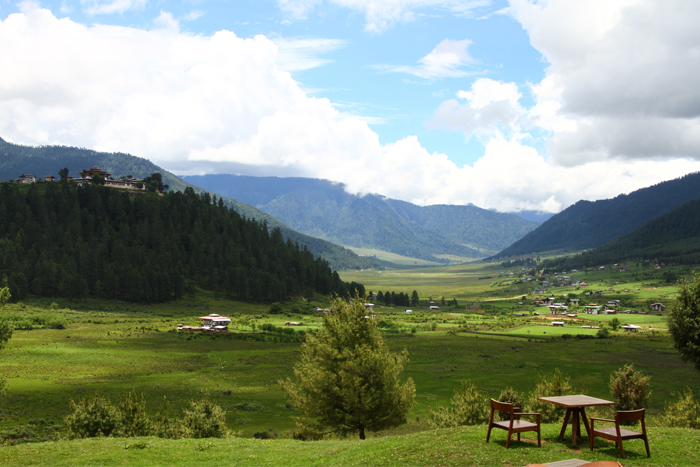BHUTAN HAPPY LAND TOUR
$1300





Tour Summary
In 13 days, we travel through the historical and cultural bastions of the Kingdom and enrich ourselves with a very comprehensive picture of the Kingdom. Apart from history and culture, the different lifestyles of the people in each valley not to speak of the immeasurable natural beauty and a plethora of flora and fauna await you. Through this tour you will gain insight into how the Bhutanese society is structured, the old time values, etiquettes and Buddhist beliefs the people cherish and how, all of these put together, serve as the enabling environment in which happiness is pursued and obtained.
Starting Point: Paro, western Bhutan
Exit Point: via Samdrup Jongkhar, south-east Bhutan, for departure flight from Guwahati, Assam
Best Seasons: March through May, & September through November
Highlights: Festivals, History, Culture, Lifestyle, Happiness, Flora and Fauna,
Day 1: Bangkok/Delhi/Katmandu – Paro
Highlights: Spectacular views of Mt Everest (8,848 m), Kanchenjunga (8,586m) and Lhotse (8,414 m); and an adrenaline-pumping landing on the roof of the world.
Land at Paro, the country’s only international airport. It is an exhilarating flight, as the route traverses parallel to the mighty Himalayas enabling passengers to see the world’s highest peak, Mt Everest, and many more. The descent gives a panoramic view of Bhutan’s foothills culminating into a thrilling landing at what is considered one of the world’s most challenging airports.
We devote the afternoon to sightseeing around the Paro valley famed for its natural beauty, historical monuments, agricultural farms and quintessentially Bhutanese village communities. Visit the National Museum, formerly a watch tower, and then the Castle on a Heap of Precious Jewels or Rinpung Dzong. End the day with a stroll around Paro town.
Day 2: Paro Valley
Highlights: Hike to the Tiger’s Lair, the most famous Buddhist monastery in the Himalayas, built on a sheer rock -face.
After breakfast, drive for half an hour and start the hike to Taktsang monastery renowned in the Himalayan Buddhist world as one of the most popular sites of pilgrimage. The five-hour round trip follows an ancient but oft-trodden footpath flanked by water-driven prayer wheels.
The temple, precariously perched on a hair-raising ravine about 1,000 metres above the valley floor, is considered sacrosanct as it was in a cave within this temple that the eight century tantric saint, Padmasambhava, subdued the evils who obstructed the teachings of the Buddha. The saint is believed to have come to Taktshang riding a wrathful tigress. Over the years, many Buddhist saints have meditated in and around the temple and discovered numerous hidden Buddhist treasure teachings.
Visit the ruins of Drugyel Dzong, “Castle of the Victorious Drukpa”, from where Bhutan repelled Tibetan invasions in the 17th and 18th centuries. We can also get a view of the sacred mountain, Jomolhari, along the way. Visit the 7th century Kyichu Temple, believed to have been built in the 7th century by the Tibetan King Songsten Goempo on a place that resembled the knee of a giant ogress. Legend has it that Kyichu is one of the 108 monasteries that the King built in one day.
Day 3: Paro-Thimphu
Discover Bhutan’s capital, the power centre and hub of culture, art, and commerce.
Our Thimphu’s sojourn will begin with a drive to the Buddha Point (Kuensel Phodrang), where the world’s tallest Shakyamuni Buudha statue is located. Buddha Point provides a spectacular 360 degree close-quarter view of entire Thimphu and the adjoining areas. Next we visit the 12th century Changangkha Lhakhang (temple), considered the spiritual home of children born in the Chang region of Thimphu. From here we go to the Takin Reserve and then to Sangaygang, from where the entire Thimphu valley can be seen. On the way back, we stopover at a nunnery, the Folk Heritage Museum, and the Textile Museum.
After lunch, we will proceed to Tashichho Dzong, a 17th century castle-fortress which today houses the offices of the King, Chief Abbot and government ministries. We will also take the opportunity to see the nearby parliament complex, the School of Arts and Crafts, vegetable market, and then spend the rest of the day watching an archery match and strolling around the town.
Day 4:Thimphu – Punakha/Wangduephodrang
Distance: 77 kilometres, Time: 3 hours
Highlights: A panoramic view of the snow-capped eastern Himalayas and a multitude of alpine flowers and birds; Bhutan’s ancient capital and Temple of Fertility.
The three to four-hour drive from Thimphu traverses a constantly changing kaleidoscope of vegetation, waterfalls, flowers, mountains and meadows. In about 45 minutes we reach the famous Dochula pass (3,100m) where on a clear day we can see the entire eastern Himalayan range, filled with 6,000m to 7,554m snow-capped mountains. The pass also known for its abundant species of extremely beautiful flowers has 108 Buddhist stupas exquisitely built around a mound, adding to the natural splendor of the place.
From the pass we descend to the sub-tropical valley of Punakha. Punakha served as the ancient capital of capital and still possesses the country’s main treasures in the form of Buddhist relics. Resembling a gigantic ship on an ocean floor from afar, and girdled by two (Male and Female) rivers, the castle-fortress also represents the best specimen of Bhutanese architecture.
After lunch in a small nearby village together with a rural farming household, we will walk along a footpath flanked by an endless view of ripening paddy fields to the Temple of Fertility – Chimi Lhakhang. This temple, built in the 15th century to honour the “Divine Madman”, a saint iconoclast who is also associated with phallus worship, attracts barren couples from all over to receive fertility blessings from an anointed phallus.
Day 5:Punakha/Wangdue–Trongsa
Distance: 120 km; Time: 6 hours
Highlights: Landscape, semi-nomads, diverse vegetation, and sighting of high altitude birds and animals enroute
We will visit the ruins and reconstruction work underway at Wanduephodrang, a fortress which was built in 1638 but was gutted in 2012. We take a short leisurely stroll in Wangdue town. If lucky, we might be able to sight the White-Bellied Heron cavorting on the river bank. This is one of the rarest birds in the world.
The journey to Trongsa is a gentle climb, from the sub-tropical to the sub-alpine region with the highest point at Pelela Pass (3,300m) We will notice the vegetation transform right before our eyes. To reach the pass, we will be skirting the periphery of the world’s largest winter habit of the exotic and the rare Black-Necked Crane. Pelela pass itself is historically significant as the boundary between eastern and western Bhutan before the country was unified. From Pelela we drop to the slightly lower valleys inhabited by the semi-nomads who live off yaks and whose lifestyles have largely resisted the forces of modernization.
After lunch at the 18th century Chendebji, a replica of the Boudanath Stupa in Nepal, we continue eastward to Trongsa proper, the bastion of the powerful governors in ancient Bhutan who eventually unified the country and became the progenitors of Bhutan’s hereditary monarchy.
Day 6: Trongsa – Bumthang
Distance: 70 km; time: 3 hours
Highlights: Trongsa palace-fortress, Black Mountain range, and local textile
We visit Trongsa Dzong, the biggest palace-fortress in the Kingdom reputed to have been built without using a single iron nail. This fortress has for centuries been the vanguard of powerful warriors, one of whom even led successful expeditionary forces against British-Indian army in the southern boundaries of his domain. We complete our Trongsa stopover with a visit to the Watch Tower, Ta dzong, which is today preserved as the Museum of Bhutanese Kings.
The drive to Bumthang is initially an upward ascent for nearly half the journey till we reach the highest point at Yotong La pass (3,400 m). After a brief stop to view the Black Mountain range, we drive towards Chumey entering the country’s most expansive and beautiful valley known as Bumthang or a “literally – “Meadow of A Beautiful Vase”.The women of Chumey are known for their exquisite Yathra – a clothing with intricate floral patterns woven out of sheep’s wool.
Day 7: Bumthang
Highlights: Monuments and structures which bring alive the exploits of saints and kings
In this valley of myths and legends lies one of the oldest surviving man-made structures in Bhutan, a temple dedicated to Buddha Shakyamuni, Jambay Lhakhang, built in 639 AD. The temple was built to fulfill an oath by Tibetan emperor Songsten Gampo to subdue a demoness who lay spread-eagled across the Himalayas obstructing the teachings of the Buddha. Our next visit will be the Castle of the White Bird (Jakar Dzong) whose central tower (utse) is the tallest in Bhutan.
From Jakar, we drive to Chakhar and then to Kurjey Lhakhag. Albeit oblivious today, Chakhar is the site of the legendary “Nine-Storied Iron Castle” built by Sindhu Raja (king) in the 8th century and the innumerable myths surrounding it. Kurjey, meaning “Body Imprint on Rock”, has temples built against a wall of cliff. The imprint belongs to the 8th century saint Padmasambhava who mediated in a rock cave and, using his tantric powers, subdued the evils who tormented the people in the vicinity.
After lunch at our hotel, we drive to Tamzhing monastery which preserves the remains of the works of Terton Pema Lingpa who, in the 15th century, discovered many secret tantric teachings hidden by Padmasambhava. Pema Lingpa was an artist and sculptor extraordinaire but, more importantly, one of the five “King Tertons” – treasure revealers – of Vajrayana Buddhism. Our last visit for the day is the “Burning Lake” in Tang where Pema Lingpa, challenged by a local warlord, took a dive into a pool with a lighted butter lamp on his head and re-emerged from the lake with the lamp intact holding a hitherto unknown statue in his hands.
Day 8: Bumthang-Mongar
Distance: 180 kms; time: 8 hours
Highlights: Thrumshingla National park, Rhododendron Garden, Lingmethang Birding Area, ruins of Zhongar dzong
Today, we take a beautiful drive across farms and villages, and gentle undulating valleys to Thrumshingla pass (3,750m). This place is part of a protected area that is dubbed as the “Crown Jewel” of conservation in the eastern Himalayas. Here we have a in situ rhododendron garden, some 30 species in all, not to speak of numerous varieties of other plant species. For birders, this area is the ultimate destination, with some 600 species sighted, some of which are extremely rare and localized.
The descent from Thrumshingla to Lingmethang is another exhilarating experience. In less than two hours we witness an altitude drop from 3,800 meters to 650 meters. As a result, we enter one vegetation zone to the other, from the sub-alpine to the temperate to the sub-tropics. We can also see the ruins of Zhongar Dzong which was, once upon a time, the palace and fortress of a powerful regional chieftain but is now preserved as a showpiece of Bhutan’s yesteryears. As we reach the lowest point in Lingmethang, we come across a beautiful run-of-the-river hydroelectric dam flanked by two mountain ridges.
Day 9:Mongar-Trashigang
Distance: 91 kms; time: 3 hours
Highlights: Korila Pass, hamlet at Yadhi, Drangmechu basin, Trashigang town.
From Mongar onward we are in the Tshangla (local language) speaking belt of Bhutan. The customs, traditions and lifestyles are all slightly different from western and central Bhutan. The physical terrain is steep and rocky with the farm houses and villages practically clinging onto steep hill and mountainsides. Our drive from Mongar to Trashigang takes us through several villages with the highest point being Korila Pass (2,450m). Here on, we descend all the way to Dangmechu (the largest river system in Bhutan), through a mid-way town called Yadhi, finally winding down a series of thrilling zig zags (road bends). Near the riverbank, we see the remains of an iron chain bridge built in the 14th century. From here, another 12 kilometers uphill is Tashigang dzong, the most powerful power centre in medieval eastern Bhutan. We visit the Dzong and take a stroll in Trashigang town.
Day 10 : Trashigang-Tashiyangtse-Trashigang
Distance: 55 kms; time: 2 hours
Highlights: Gomphu Kora sacred site, Chorten Kora stupa, Duksum town, woodwork
We drive to Tashiyangtse today, a small town rich in Bhutanese arts and folklore. On the way, we pass through the small town of Duksum located on the Drangme Chhu and its tributary river. Just before Duksum is the sacred site called Gomphu Kora, which attracts people from all over eastern Bhutan for three days in March when its annual “Festival of Circumambulation” is underway. A large rock stands there and it is believed that the “Vase of Immortality”, brought from the Maratika caves in Nepal, was hidden in the rock by a Buddhist saint in the 8th century AD.
We reach Trashiyangtse proper by passing through numerous villages, waterfalls, and landscapes of amazing beauty. In Trashiyangtse we see the famous Chorten Kora said to have been built by entombing alive a princess from the Dakpa tribe in present-day Arunachal Pradesh (India). Trashiyangtse is also famous for woodwork, boasts an institute of art and craft in its main town, and is the habitat of the rare Ludlow’s Bhutan Swallowtail butterfly and Black-Necked Crane.
Day 11 : Trashigang town-North Trashigang-Trashigang town
Distance: 40 kms; time: 3 hours (to and fro)
Highlights: Rangjung Monastery, Farms, Villages, Dakpa Tribe, Bura Weavers, Local Customs
Today, we enter the most populated part of Bhutan. The drive is short and scenic as we follow the course of a river called Gamri which is, among others, known for producing Bhutan’s most delicious indigenous carp. We visit Rangjung Monastery, the biggest centre of Nyingma (Dudjom Tersar) Buddhism in the district. After mingling with the monks at the monastery, we drive further up to the village of Radhi (known as the “rice bowl” of eastern Bhutan) where we meet women weaving Bura (raw silk cloth pieces) using back-strap loom in open terraced rice fields during winter. After lunch at a local farmhouse, we drive further up the mountain to see the lifestyles of a tribe called Dakpa in Phongmey village and then return to our lodge in Trashigang town.
Day 12: Trashigang–Samdrup Jongkhar
Distance: 180 kms; time: 7 hours
This is the last stretch of our tour in Bhutan. The drive is long but not so monotonous as there is so much to see enroute. A short drive from Trashigang town takes us to Kanglung where Bhutan’s first degree college is located. It is in this campus that most of Bhutan’s present leaders, planners and businessmen received their modern education. From here, we pass by an ancient temple at Yonphu (famed for its unique mask dances), the monastery complex at Yongphula, and the Zangtopelri temple in Barshong (in the olden times, the people here mined iron and made steel implements like traditional Bhutanese sword). A little further away is the village of Khaling where Bhutan’s only “School for the Blind” is located. We will stop here awhile and have a heartwarming interaction with the students before heading further down to our destination in Samdrup Jomngkhar via Wamrong, Narphung and Dewathang. Dewathang is the site where the British and Bhutanese forces fought a battle in the 19th century over territorial dispute. A common site along this way is the dwellings raised on stilts and roofed with bamboo mats.
Day 13: Samdrupjongkhar–Guwahati and fly out
After breakfast, we drive 154 km in three hours to Gawahati Airport through the beautiful plains of Assam (India). Adios! Sayonara! Arrivederci! Ciao! Auf Wiedersehen! Bon voyage! Zàijiàn! Farewell Bhutan, farewell Happy Kingdom.
|
GROUP SIZE: Any group Size |
TRIP SEASONS: Throughout year |
INCLUDED
- Bhutan Royalties, tourists fees, Visa fees and taxes.
- Accommodations in listed or similar hotels (pleasant hotels 3-4 star type) during the tour and in tents during the trek.
- All meals, including evening tea/coffee etc through-out the trip.
- All land transfers, sightseeing with entrance fees.
- Experienced Culture Tour Guide.
- Bottled water in the vehicle and other camp serivce.
NOT INCLUDED
- Flights in and out of Bhutan.
- Travel insurance, Drink, Visa fees, Laundry
Related Tour
-
The Dragon Acquaintance Tour
As suggested by the name, this package...
$400 -
Insights of Bhutan Tour
There is an adage that seeing is...
$500 -
Into the heartland
Apart from the wonders and beauty of...
$900 -
The Dragon Tour
This package provides you the opportunity to...
$800 -
The Cross Country Tour
If you are looking for an adventure...
$1700 -
GLIMPSES OF BHUTAN TOUR
We explore western and central Bhutan. We...
$900 -
Bhutan fairyland Tour
Culture, architecture, nature, history, and people –...
$1100












